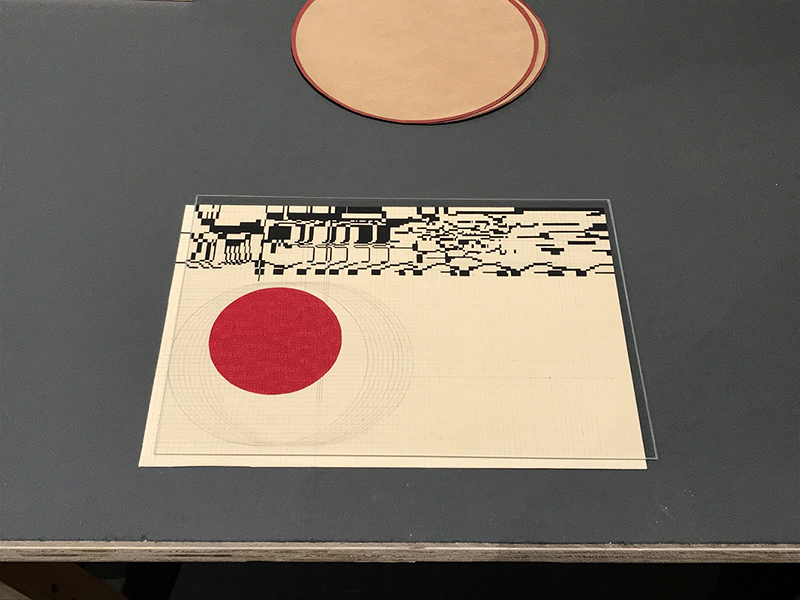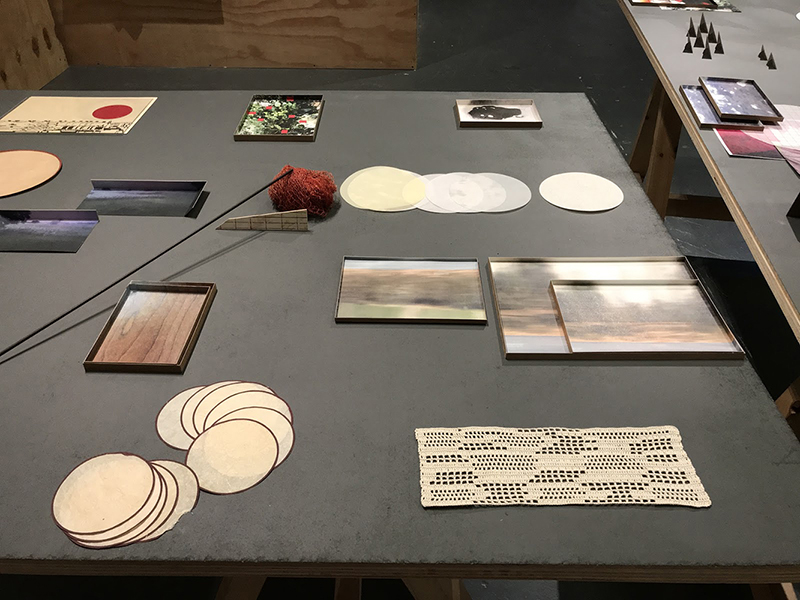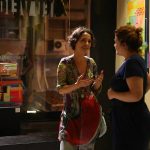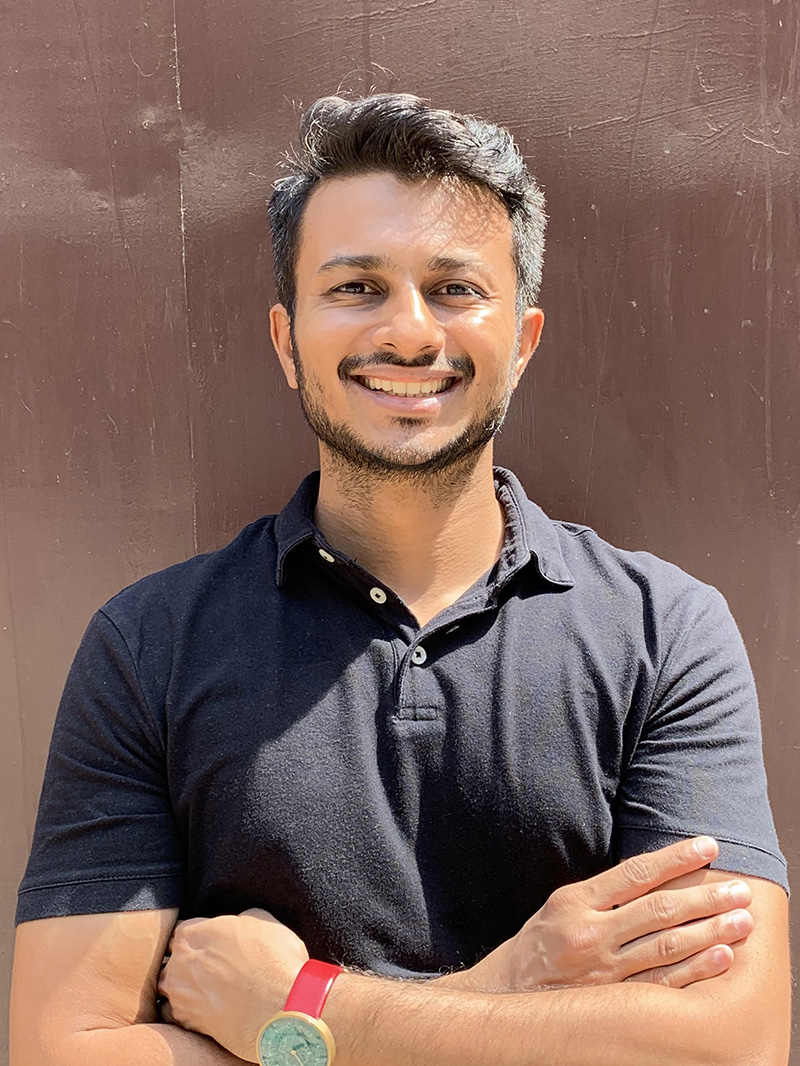For contemporary artist Rujuta Rao the choice of medium is an extension of thought.
In 2018, I underwent a rigorous training in bartending under the brilliant bartender Evgenya Prazdnik. Cocktails to me are like ingestible objects, and like my objects, a way to engage with people. I have been thinking about the role of the bartender, the performative act of making cocktails, the bartender as a confidante and the power involved with getting someone slowly inebriated. The bar acts both as a buffer from the world and a platform to engage with it.
Featured image: Exhibition View. Serendipity Arts Festival 2019 | Image credit: Serendipity Arts Festival, photograph by Sunil Thakkar.
Please tell us a little about yourself. What brought you to the world of art and how did you start?
I had always enjoyed making objects, drawings and working with photographs. Recently, I had to go through the things I had made from the age of four and surprisingly little has changed. Some of the questions, obsessions and preoccupations are still the same. What I’m amazed by is the sheer volume, especially when it comes to writing.
As a child I had begun working with various materials like paper pulp, wood, photographs etc. I remember this need to make getting amplified as a result of trauma since the age of three. This coupled with not having a strong sense of belonging and community, being an introverted, only child caused me to create a vibrant inner world from where these objects stemmed from. I would carry them around to share them with people. They became the medium through which I communicated with the world. I still prefer sharing my work in similar ways.
In 2018, I underwent a rigorous training in bartending under the brilliant bartender Evgenya Prazdnik. Cocktails to me are like ingestible objects, and like my objects, a way to engage with people. I have been thinking about the role of the bartender, the performative act of making cocktails, the bartender as a confidante and the power involved with getting someone slowly inebriated. The bar acts both as a buffer from the world and a platform to engage with it. The solitary process of preparing the mise en place which then culminates in a cocktail served to the customer is a very similar process to how I create and share my objects.

Garment by RAO | I use photographs as animistic objects often inserting them in the garments.
How do you describe yourself in the context of challenging people’s perspectives via your work?
I don’t. There is never the need to challenge. The need is always to create alternative modes of engagement because I’m dissatisfied with the existing modes. These alternative modes might be new so they might challenge people’s perspectives, but that is incidental.
In 2019, I received the fine arts grant from the Serendipity Arts Foundation which culminated in a show at the Serendipity Arts Festival 2019. I encouraged people to come in and interact with the objects. People could come into the space, move the objects around, try on the garments, interact with me and spend time in the space. I was present in the space not just to explain my work but to engage with the viewers through the objects. The space was made to look like it was something between a shop, an installation, a studio, a gallery and a workshop. This was new to that particular audience and it was certainly the first time I was presenting my work in this manner. Both parties were challenged and the result was a symbiotic learning of the possibilities of sharing and experiencing art which led to new kinds of intimacy.
How do you deal with the conceptual difficulty and uncertainty of creating new work?
This process for me is both delightful and excruciating. It is a process fraught with anxiety, moments of self-flagellation and self-doubt. It is accompanied by a rigorous practice in making and studying. I have recently been haunted by wanting to resolve my works conceptually and to have answers to every why. Yet, the more I try to have all the potential questions answered, which for me is an impossible task, I find that the work becomes redundant. I start losing interest in making it. I have come to understand that I’d like to always be in a state of asking, but never in a state of having all the questions answered. The process of finding answers should only make the work more complex and raise new questions. I’d like the state of resolution to be always aspired towards but to be perpetually elusive.

The Rejoinders residency and exhibition at g39 gallery, Cardiff. Image credit: Polly Thomas.
Let’s talk about your frameworks, references and process. What inspires you?
I have recently been working on a story which informs a lot of my work. This is the story of a lady who teleports. But for some reason, each time she teleports from one location to another she leaves a part of her body behind. Yet she continues to teleport, leaving behind a trail of body parts in several different locations. Eventually she ends up heavily fragmented. Apart from leaving behind body parts, she also carries with her fragments of the furniture that her body is being supported by at the moment of teleportation. For example, she might carry an arm of a chair or the leg of a stool. This is not a tragedy. It is a condition, a situation, a matter of fact – even in its fiction. To keep herself from fragmenting, she creates harnesses to hold her body together, but in vain.
I am now making garments as a part of my label RAO. These one-off pieces are an extension of my sculpture practice which I show with the rest of my objects. I am enjoy working between the spaces of art and design. A lot of my garments stem from the need to harness. To tie up and be held together and the need for bodily cohesion. At the same time the deconstructed garments point at bodily fragmentation.

Gouache on paper. The Rejoinders residency and exhibition at g39 gallery, Cardiff.
Let’s talk about the evolution of your practice over the years. Tell us about your commitment to your current medium. What would you call your style?
I am not committed to a medium. I choose my medium based on what the work demands. I think through the medium. The choice of medium is an extension of the thought.
I now work with the materials available to me, what I find in my periphery. Images of my surroundings. This allows me to sustain my practice through financial ups and downs and to make art on the go, with or without a studio.
My undergrad in sculpture at MSU Baroda was focussed on learning how to be proficient in a variety of sculptural mediums. Any conceptual or critical inquiry was discouraged. My MFA at Parsons School of Design was quite the opposite. The obsessive focus on critical theory made a lot of us feel blocked when it came to our studio practice without having layers of theory to validate our works. I think both processes are very important and each person finds their own balance of working through both. My time after Parsons has been about finding that balance for myself and about how and when each process comes into play.
After my MFA, I spent a year (2014-15) in New York City attending workshops with Movement Research Inc. and in the Alexander Technique. I wanted to have an embodied experience as against having a constantly disembodied and critical perspective, which made me look at my body as a fragmented entity as I fixated on various parts instead of experiencing it as a cohesive whole. The harnesses in my story of the teleporting lady have now replaced that movement – they physically hold her body together. The jobs I was doing during this time were related to experimental and independent film. I was helping The Film-Makers’ Cooperative with their analogue film archive. Here, I was exposed to the works of the likes of Michael Snow, Hollis Frampton, Maya Deren, and Dziga Vertov whose works influenced me greatly. I believe that my photo trays were influenced by working with analogue film. They are stills from videos printed out and turned into trays, making them more object-like. They can be stacked up, moved around, their linear sequence is broken. Here, the prescribed time of a moving image is replaced by physical space. What I’m trying to say is that my work has evolved in ways I wouldn’t have expected. It’s impossible to talk about evolution of work as a linear, traceable process. It’s unexpected, surprising and very often incomprehensible.

Let’s talk about your career, or if you prefer artistic journey. What were your biggest learning and hiccups along the way?
In 2015, I moved from NYC back home to Goa and started living with my parents after 12 years of being away. In 2017, I was invited to do a month-long residency at the CONA Foundation in Mumbai and in 2018 I attended the The Rejoinders Residency in Cardiff which I was nominated for. This residency culminated in a show at the g39 gallery in Cardiff. I showed objects along with an album of sound pieces for this show. Between 2015 and 2019 I didn’t feel ready to apply to shows, residencies or grants. So I had four years of a solitary practice of making art without sharing it. My biggest learning in the four-year period has been about how to sustain a practice despite not feeling ready to show the work. It was also a time of formulating the context within which I wanted to show my objects. Something I’m still trying to figure out. I think what really kept me at it is discipline and that I make because I’m compelled to make. The practice of making keeps me grounded and gives me a sense of balance. The more I work at it the closer I get to what I want to express and that is very fulfilling. It’s like the process of distilling.
How does your audience interact and react to your work?
I will never have a complete idea about how they interact and react to my work. Different audiences respond differently to the work based on the location and context it is shown in.
I have been playing with representation and abstraction; familiar objects along with unfamiliar objects. Trying to use familiarity as a gateway towards the unfamiliar, towards the abstract.
I am curious about how the presence of certain objects transforms the space and the behaviour of people in it. How having a carpet with objects sitting on it changes the viewers’ behaviour around those objects and their relationship to the floor. I have often been told that there is a silence to the objects, an order that elicits intimacy between the viewer and the objects that calls for a tactile engagement.
I have been playing with how seemingly functional objects are rendered non-functional or their function is subverted. The space does this too in the way that it appears to be a shop or a workshop but isn’t one. This lends the work to be perceived as being satirical. Last year I registered a “trading” company which has no product to sell but applies for several government permits that it can’t receive to generate paperwork. A degree of deception and play are important to me.
For my work at SAF 2019, I was trying to figure out how to invite the audience into the space without being prescriptive or didactic. I was also trying to think about how to make the wall text more accessible instead of alienating the audience with a wall of jargon which I experience at shows often. People responded immediately to this by engaging with me and the objects. There seemed to be a sense of joy in moving things around and trying on the garments. I learnt that people felt more comfortable touching the objects if the space resembled a shop more than a gallery. This worked very well for my work at the Goa Open Arts Festival 2020.

The Rejoinders residency and exhibition at g39 gallery, Cardiff. Image credit: Polly Thomas.
What are you looking for when you look at other artists’ work? Which shows, performances and experiences have shaped your own creative process? Who are your maestros? Whose journey would you want to read about?
I am looking for a visceral response, to be stimulated visually and intellectually, and to learn from their process.
These are my maestros. I think of them as companions and at times as family with whom I have conversations: Nasreen Mohamedi, Rei Kawakubo, Chantal Akerman, Theresa Hak Kyung Cha, Michael Snow, Hito Steyerl, Padmini Chettur, Agnes Varda, Chris Marker, Trinh T. Min-Ha, Ralph Lemon, Maya Deren, Simone Forti, Pina Bausch, Agnes Martin, Ray Johnson, Dziga Vertov and so many many more.
Chantal Akerman’s Jeanne Dielman, 23 Commerce Quay, 1080 Brussels have had a profound impact on me and on my work. So has Hito Steyerl’s book The Wretched of the Screen especially the essay In Defense of the Poor Image and her essay documentaries in which she constantly addresses her position as the author. Theresa Has Kyung Cha’s Dictee has helped me with my use of language, text, image and grammar and her book Apparatus was my first introduction to Jean-Louis Baudry’s writings and to the apparatus theory. Dziga Vertov’s Man with a Movie Camera and Trinh T Min-Ha’s Surname Viet, Given Name Nam have influenced by sculptural renditions of cinematographic techniques.
What is the best piece of advice you have received? Why was it helpful?
Sol Levitt’s letter to Eva Hesse in which he asks her to just DO! which is to continue making art without paying heed to any internal or external criticism and resistance. This letter helps me overcome the traps of wanting to completely resolve the work before starting it and to overcome hurdles of self-doubt.
My professor, artist B. V. Suresh once told me to stop waiting for the right moment to show my work, to stop waiting for it to be perfect and to show the work at whatever stage it may be. This helps me put the work out there to understand it better, be able to take new steps after the experience of sharing it and to make room for new ideas.

The Rejoinders residency and exhibition at g39 gallery, Cardiff. Image credit: Polly Thomas.
Tell us about your studio. Could you describe your usual work day in the studio?
I don’t have a studio. I work at home. In the kitchen and in the living room and in corners. Amidst family. I work on the move. This helps me keep the work small, mobile and flat-packable. My work is very close to my life and to how I live. What keeps me going isn’t a fixed space as much as it is discipline.
I wake up, write and practice dance/movement. The rest of the day involves making objects, drawings and the work at hand. Recently, my label and the garments are what I have been spending most of my time on. I read in the evenings or watch a film and write again before I sleep. This ritualistic way of making art has really helped me. I show up to work irrespective of whether I feel like it or not.
Are you more of a studio artist or naturally collaborative by nature?
Conversations with friends and peers have always been important to my work. My parents have tirelessly helped me set up every show. The works and thoughts of other artists, filmmakers, writers, musicians, chefs have been of great influence and inspiration. Even if the making of the work is a solitary process, there is a level of collaboration in these exchanges which make the work what it is. The question would then be about where collaboration lies and what we define it as.
For me, the need to collaborate began in 2015 when I moved to Goa from New York City and was having a hard time coming to terms with this move. This is when I started a project called WT Derivative with friends and artists I had met during my time in NYC and wished to stay connected with. This project involved them sending me a list of instructions to make a work of art which I would then follow. The instructions could be detailed or open ended. The questions I hoped to address were: about authorship – who is the author of the work – is it them as instructors or me as the executor of the work? How much control would they have over their own works even if the instructions were very detailed and specific? Who do we credit and how? This project didn’t come to fruition because I needed more time to settle down, but my collaborative work with artist Alona Weiss called Dear Abbé about the Goan hypnotist Abbé de Faria stemmed from this project.
More recently I have noticed that a large part of the intimacy I feel with others stems from meaningful collaborations.
I have been wanting to work with collaborators who are outside of the art field. For example, collaborations with brewers, chefs and architects. This is yet to happen.
What are you working on now? What’s coming next season?
I’m trying to create a system within which my objects and garments are activated through bodily gestures and changing arrangements. I am also trying to develop a practice in movement and I’m curious about where it will take me.
I am working on my label RAO. Through these garments I am thinking about gender in clothing. I am learning about and trying to incorporate sustainable practices within the making of my garments. As of now the garments are either made from repurposed clothes, surplus fabric or from naturally dyed cotton, a part of which is organic.
I have a residency at the Vermont Studio Center that is coming up this year.

Exhibition View. Serendipity Arts Festival 2019 | Image credit: Serendipity Arts Festival, photograph by Sunil Thakkar
Is there any topic lately that you would like to be mentored on?
I’d like to be mentored in dance/movement techniques, writing, somatic experiencing, brewing and in understanding beer.
For enquiries contact: rujutaraostudio@gmail.com
Before you go – you might like to browse our Artist Interviews. Interviews of artists and outliers on how to be an artist. Contemporary artists on the source of their creative inspiration.












Add Comment